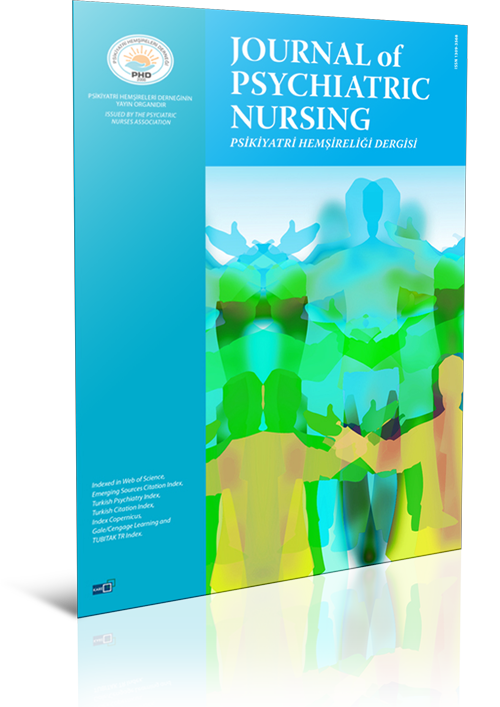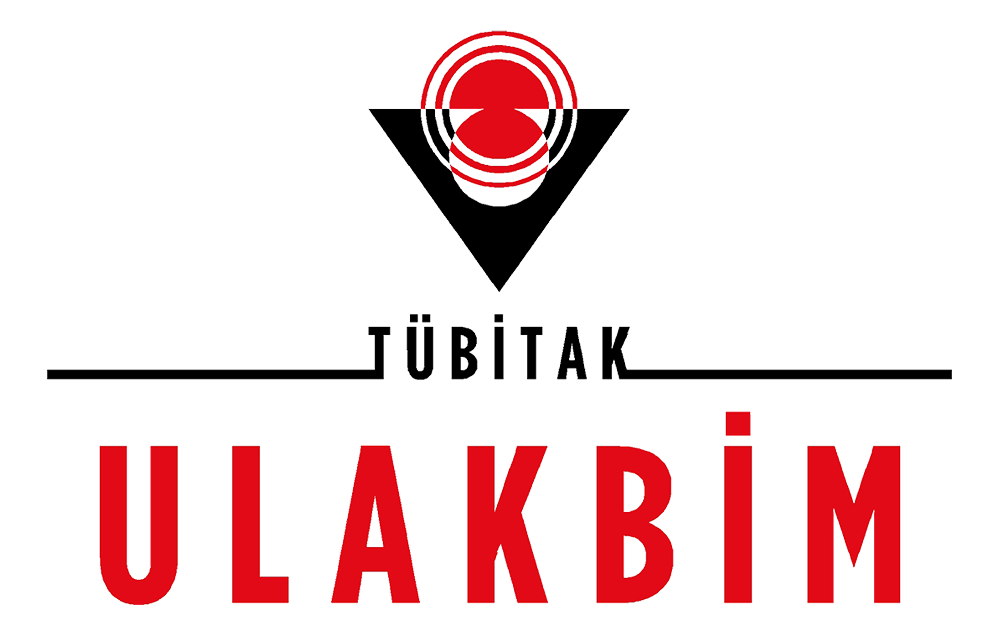
Volume: 9 Issue: 1 - 2018
| 1. | Frontmatter Pages I - III |
| EDITORIAL | |
| 2. | Editorial Nurhan Eren, Nazmiye Kocaman Yıldırım Page IV |
| RESEARCH ARTICLE | |
| 3. | Determination of psychiatric clinic nurses knowledge, attitudes, and practices regarding the use of physical restraints Ahmet Göktaş, Kadriye Buldukoğlu doi: 10.14744/phd.2017.38247 Pages 1 - 10 INTRODUCTION: This study was carried out to determine nurses knowledge, attitudes, and practices regarding the use of physical restraint in psychiatric settings. METHODS: This descriptive study was conducted in seven psychiatric hospitals in Turkey between May and October 2015. The attempt was to reach an entire study population without any sampling; it was completed with 304 nurses (62.8%). Data were collected using the Scale for Nurses Knowledge, Attitudes and Practices Regarding Physical Restraints and a Questionnaire Form, and then assessed with SPSS software, using descriptive statistics, t-test, Mann-Whitney U test, Kruskal-Wallis test, and a Kolmogorov-Smirnov normality test. RESULTS: Nurses knowledge about the complications of using physical restraint was lacking; most nurses (65.8%) did not use alternative methods instead of physical restraints. It was found that nurses knowledge level regarding physical restraint was good, attitudes were negative, and practices were close to excellent. The mean knowledge score of nurses who did not use physical restraints (p=0.031) was statistically higher than others. The mean attitudes scores of nurses whose age was between 20 and 35 (p=0.044), who were bachelors (p=0.026), and who did not use physical restraints (p=0.034) were statistically higher than others. The mean practice scores of women (p=0.005) and nurses who had over 10 years clinical experiences (p=0.03) were statistically higher than others. DISCUSSION AND CONCLUSION: Nurses knowledge level regarding physical restraint was good, although attitudes were negative, and practices were nearly excellent. The suggestion to hold comprehensive and practical training programs promoting nurses knowledge, attitudes, and practices regarding physical restraints for nurses arose from these conclusions. |
| 4. | Early period self-care ability and care requirements of schizophrenia patients after discharge Sultan Taş, Kadriye Buldukoğlu doi: 10.14744/phd.2017.64935 Pages 11 - 22 INTRODUCTION: This descriptive study was conducted to determine early-period self-care ability and care requirements of schizophrenia patients after discharge. METHODS: The study population comprised 31 schizophrenia patients who received inpatient treatment between April 2013 and April 2014 in Akdeniz University Hospital Psychiatry Clinic then discharged. Data collection took place during the first two weeks after their discharge using the Self-care Ability Scale and Care Requirements Determination Form. RESULTS: Self-care ability general point average of all individuals studied was 99.32±21.86; that of individuals, who were single, did not have children, had a single child among those who had children, or had a family member with mental disease was significantly lower. Study patients had significant requirements in terms of self-concept, coping, need for knowledge, sleep, roles and relationships, treatment and care, safe environment, self-care and spiritual dimensions. DISCUSSION AND CONCLUSION: This study provided meaningful data on early-period self-care ability and care requirements of schizophrenia patients after discharge. Nurses working in the psychiatric clinic will benefit from these data when planning discharge. |
| 5. | Determination of sleep states before and after sleep hygiene training in psychiatric patients Nezihe Uğurlu, Nazife Kostakoğlu, Duygu Ağca, Leyla Tekin doi: 10.14744/phd.2017.60490 Pages 23 - 28 INTRODUCTION: The study assessed sleep disorders in patients receiving psychiatric services and the contribution of nursing education in addressing these disorders. METHODS: A semi-experimental study was conducted with 51 patients (23 females and 28 males) hospitalized in the Psychiatry Clinic of Muğla Sıktı Kocman University Education and Research Hospital between November 2002 and March 2013. Research data was collected using a personal information form and the Pittsburg Sleep Quality Index (PSQI). The surveys were given using a one-to-one interview technique in the hospital room between 19: 00 and 22: 00 hours. The status of the patients before the education was determined. Patients were educated and encouraged to apply interventions for one week. Patients were reassessed after one week of intervention. RESULTS: The average age of patients participating in the study was 46.24±14.54. At the end of the study, a statistically significant difference was found between the pre-training and post-training sleeping states of the patients (t=0.000, p<0.05). When the pre-training and post-training sleep quality score distributions were compared, all seven components exhibited a significantly positive increase. DISCUSSION AND CONCLUSION: This study shows that psychiatric patients with sleep disorders can improve their sleep quality following the use of appropriate nursing initiatives. When the total sleep quality scores were examined, the pre-training sleeping state of the patients was poor, but after the training, a significant improvement was observed (t=0.000, p<0.05). |
| 6. | The relationship between personality characteristics and workplace bullying of nurses Ayşegül Savaşan, Gönül Özgür doi: 10.14744/phd.2017.66487 Pages 29 - 35 INTRODUCTION: The aim of the study was to determine the relationship between personality characteristics and workplace bullying of nurses. METHODS: This descriptive and relational study was carried out with 260 nurses working in a university hospital. Data were collected using a socio-demographic questionnaire form, the Hacettepe Personality Inventory and the Negative Acts Questionnaire. RESULTS: The mean age of the nurses was 35.6±7.9. The general adjustment score of the nurses was 107.34±20.77, their personal adjustment score was 48.76±13.15, and their social adjustment score was 59.5±8.95. The nurses Negative Acts Questionnaire score was 33±1.05 (22110p). There were weak but significant negative correlations between their Hacettepe Personality Inventory scores (general, personal, and social adjustment points) and their Negative Acts Questionnaire scores (p<0.05). DISCUSSION AND CONCLUSION: It was found that the nurses had compatible personality characteristics and that they were not greatly exposed to workplace bullying. Nurses generally experienced less workplace bullying as their personal and social adjustment increased. |
| 7. | Colleague violence in nursing: A cross-sectional study Dilek Ayakdaş, Hülya Arslantaş doi: 10.14744/phd.2017.52724 Pages 36 - 44 INTRODUCTION: This cross-sectional study aimed to determine colleague violence in nursing. METHODS: This study was performed on 1376 nurses, including 646 from a university hospital and 430 from a training and research hospital in Izmir province and 300 from a state hospital in Aydin province. Research data were collected using sociodemographic questionnaire and workplace psychological violence behavior assessment and development scale. RESULTS: The results showed that 44% of nurses were in the age range of 3340 years, 89.5% were female, 55.8% were married, 46.6% had a bachelor's degree, 47% were working in university hospitals, 25.5% were working in internal medicine service, 45.7% had experience of 15 years or over, and 36.6% had an experience of 15 years. Further, 47% (n=366) of nurses had suffered lateral violence; 10.3% (n=38), 10.1% (n=37), 8.2% (n=30), 4.6% (n=17), 4.3% (n=15), 3.8% (n=14), and 3.2% (n=12) reported the reasons for colleague violence as jealousy, having a higher level of education, rivalry, being a beginner in the clinic, workload and patient density, differences in political views, and physical appearance, respectively. Also, 80.1% encountered mobbing behaviors the most, including humiliation and degradation. Moreover, 85.5% felt sorry and 84.1% worked harder in response to violent behavior. DISCUSSION AND CONCLUSION: Future studies should investigate the frequency, causes, effects, and characteristics of the violence that nurses commit against each other. They should also explore the influence of this violence on patient care activities and service quality. |
| SYSTEMATIC REVIEW | |
| 8. | Three phases of cancer in the process of mental trauma: Diagnosis, treatment, survival Perihan Güner, Vedat Şar, Tuğba Pehlivan doi: 10.14744/phd.2017.79663 Pages 45 - 54 INTRODUCTION: Cancer tends to trigger a psychological response that represents a form of traumatic stress. Regardless of the nature of the noxious agent, therapeutic interventions conducted for the treatment of any post-traumatic reaction must take into consideration the tri-phasic structure of adaptation (i.e. shock, mourning and integration) in defining a balanced response to a vital threat. This paper aims to gather evidence on the psychosocial dimension of cancer by applying a three-phase approach model. METHODS: To fulfill the stated aim, systematic reviews and meta-analyses on non-experimental studies published in the last 15 years were screened using the following databases: CINAHL, Pubmed, Cochrane, Joanna Briggs Institute, Ulakbim, and Google Scholar. Overall, 33 reviews met the inclusion criteria. RESULTS: The obtained data, which included findings on different types of cancer and different psychiatric reactions, disclose the presence of a psychological trauma process that occurs in response to physical illness. DISCUSSION AND CONCLUSION: The mental trauma process was studied and is discussed in three phases, namely, diagnosis, treatment and post-treatment. |
| REVIEW | |
| 9. | Mental illness and recovery Olcay Çam, Nihan Yalçıner doi: 10.14744/phd.2017.49469 Pages 55 - 60 In the traditional model, recovery from mental illness is defined as the elimination of all symptoms or the complete recovery of normal functioning. Recovery is defined as a deeply individual and unique change process, affecting attitudes, values, feelings, goals, skills and roles, despite the limitations caused by the disease. The disabled person returns to living a satisfactory life. Various recovery models have been developed, including the Watson's Caring Model, and the Tidal Model. Mental health nurses have an important supportive role in patients' lives regarding recovery. Psychiatric nurses have a unique role in helping people to develop a positive, hopeful attitude, live a satisfactory life and improve their self-efficacy. This review has been written to contribute to the inclusion in psychiatric nursing literature and services of a contemporary approach which leads to recovery. This new approach goes beyond the traditional approach regarding perception of the patient and the disease. |
| 10. | Emergency psychiatric care and mental health triage Ayşe Büyükbayram, Esra Engin doi: 10.14744/phd.2017.24855 Pages 61 - 67 Emergency service nurses provide health care to patients who come to emergency units due to mental distress. They should have the ability to evaluate their patients physical, mental and psychosocial condition, detect the risk of patients harming themselves or others, protect patients who are at risk and maintain their health care. However, good quality and effective health care cannot be provided when the physical conditions of emergency services are not appropriate, when the skills and knowledge of health professionals are inadequate, or when they have negative attitudes toward patients and there is a lack of communication between them. These problems can increase the duration of hospital stays, delay treatment, cause negative attitudes towards patients and lead to their social exclusion. Therefore, it is important to practice of mental health triage in order to reduce negative attitudes towards patients and enhance the effectiveness of treatment. Therefore, this review paper aims to determine the importance of emergency psychiatric treatment, difficulties with it, and emphasize the need for mental health triage approach. |


















